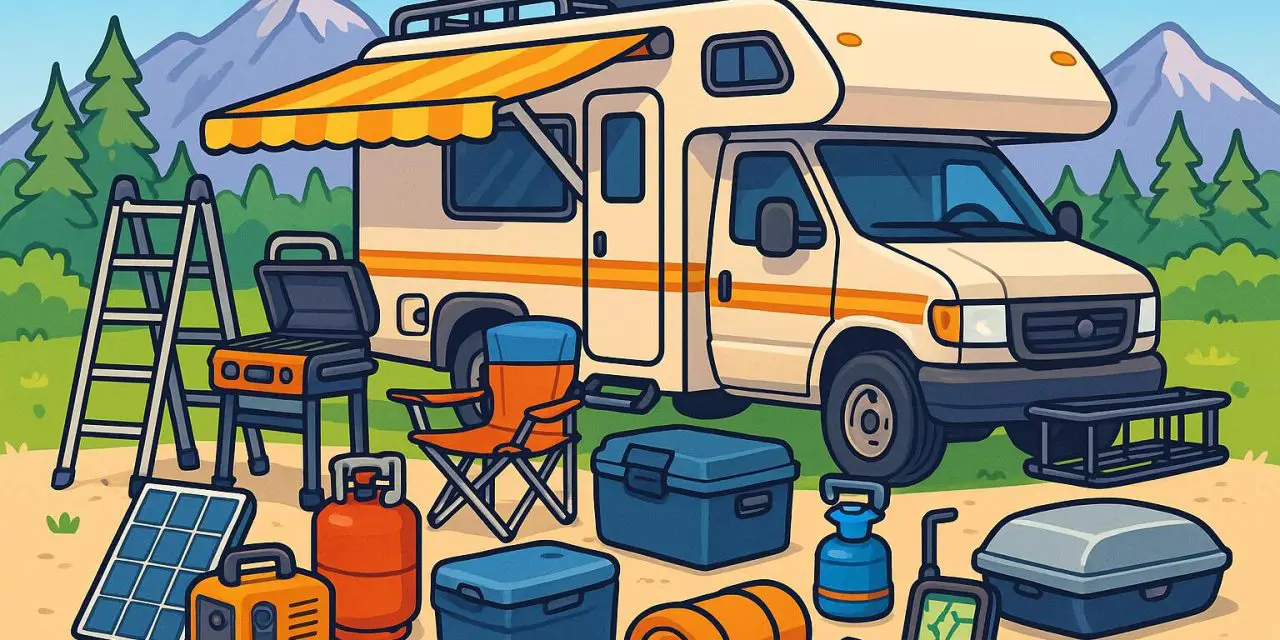Would you like to save this article?
Are you ready to discover which RV accessories could be costing you serious money? You’ve probably walked into an RV store and seen walls full of gadgets, gizmos, and gear that promise to make your camping experience better.
But here’s the truth that might shock you: many of these accessories are complete wastes of money that could leave you poorer and more frustrated than when you started. According to industry expert Josh the RV Nerd, with over 16 years of experience, there are specific items that RVers buy over and over again, only to use once and regret forever.
As someone who has seen thousands of RVs come through dealerships, he’s identified the most common money-wasting mistakes that could cost you hundreds or even thousands of dollars in repairs. In this article, you’ll learn exactly which accessories to avoid, why they’re problematic, and what alternatives will actually serve you better on your camping adventures.
1. Cheap RV Sealants – The Bubble Gum Fix
The Problem: You’ll find super cheap RV sealants at big box stores that seem like a bargain at first glance.
Why It’s a Money Trap: These budget sealants are essentially like trying to hold your roof together with bubble gum. Most RV stores don’t even carry this stuff because they know it’s more trouble than it’s worth. Think of it like health insurance – you pay money now for nothing, only to pay even more money when something goes wrong later.
What You Should Know: The correlation between what sealants RV service departments stock versus what they actually use is very high. If a dealership won’t use it in their own service center, neither should you.
The Smart Move: Walk through any RV service department and look at the sealants on their shelves. Check the reviews online for those same products – that’s what you should be buying.
Here’s Your Reality Check: You wouldn’t trust a $2 bandage to hold together a major wound, so why trust a $5 sealant to protect your $50,000+ investment?
2. Aftermarket Pin Boxes – The Frame Flex Disaster
The Problem: Aftermarket pin boxes for fifth wheels are heavily marketed as upgrades that provide a “softer ride.”
Why It’s a Catastrophic Mistake: Changing to an aftermarket pin box is one of the highest frequency causes of fifth wheel frame flex. When you change the pin box geometry, you’re altering how stress gets applied to your RV’s chassis in ways it wasn’t designed to handle.
The Shocking Statistics: According to RV industry data, modified pin boxes are responsible for approximately 90% of ladder mounting failures and related roof leaks in fifth wheels that have been modified.
| Consequence | Average Repair Cost | Insurance Coverage |
|---|---|---|
| Sidewall Cracks | $5,000 – $15,000 | Often Denied |
| Roof Damage | $3,000 – $8,000 | Often Denied |
| Frame Repairs | $10,000 – $25,000 | Usually Denied |
What The Experts Won’t Tell You: Manufacturers don’t cover warranty work when you’ve modified the chassis. Your insurance company won’t cover it either because you’ve altered the structural integrity of the RV.
Your Best Protection: Call your RV manufacturer’s customer service with your VIN number and ask if there are any approved aftermarket pin boxes for your specific chassis.
3. Mosquito Repellent Gimmicks – The Smell Test Failure
The Problem: Those trendy wristbands, sonic devices, and other “innovative” mosquito repellent gadgets promise easy protection.
The Science Reality: Mosquitoes hunt by smell, not sound or magic wristband energy. These devices are scientifically useless because they don’t address how mosquitoes actually find their targets.
What Actually Works:
- DEET: The gold standard, though it has a strong odor
- Natural alternatives: Lemon eucalyptus oil, lavender, peppermint oil
- Airflow trick: Set up a fan outdoors – mosquitoes can’t fly well in moving air
The Money You’ll Save: Skip the $15-30 gadgets and invest in a $20 bottle of effective repellent that actually works.
Your Camping Strategy: The key is overpowering your human scent with stronger odors that mosquitoes avoid, not relying on unproven technology.
4. Overpriced “RV-Specific” Toilet Paper – The John Wayne Scam
The Problem: RV toilet paper is marketed as essential for your holding tanks, often at premium prices.
The Truth That Saves Money: You don’t need special RV toilet paper! Any septic-safe toilet paper will work perfectly in your RV’s holding tanks.
What The Industry Doesn’t Want You To Know:
- RV-specific toilet paper is often just rebranded septic-safe paper
- It’s frequently more expensive than regular septic-safe alternatives
- Some RV toilet papers are actually rougher and less comfortable than standard options
Your Money-Saving Solution:
- Buy septic-safe toilet paper from any grocery store
- Test different brands at home first
- Choose based on comfort, not RV marketing claims
The Bottom Line: Septic-safe toilet paper costs 30-50% less than “RV-specific” brands and works exactly the same way.
5. Ladder-Mounted Cargo Systems – The Leak Generator
The Problem: Cargo racks, bike racks, and storage systems designed to mount on RV ladders seem convenient.
The Disaster Waiting To Happen: RV ladders are NOT cargo racks – they’re rated for 250 lbs maximum when the RV is at rest, but bouncing cargo creates forces far exceeding this limit.
Real-World Damage Statistics:
- 90% of ladder-mounted cargo leads to ladder stanchion weakening
- Leak frequency around ladder attachment points increases dramatically
- Average repair cost for ladder-related damage: $2,000-5,000
Why This Happens: When your RV bounces down the road, that “lightweight” bike rack experiences G-forces that can triple its effective weight, stressing mounting points beyond their design limits.
What Trade-In Experts See: Whenever an RV arrives with ladder-mounted cargo systems or evidence of them, the first inspection focuses on ladder integrity and roof leaks – because problems are almost guaranteed.
Your Protection Plan: If the manufacturer didn’t put a cargo system there, you shouldn’t either.
6. RV Wi-Fi Gateways – The Obsolete Technology Trap
The Problem: Built-in RV Wi-Fi systems and aftermarket gateway devices promise internet connectivity on the road.
Why They’re Worthless: These systems never worked better than your cell phone and have been completely obsoleted by better technology.
The Performance Reality:
- Most RV Wi-Fi gateways require separate expensive subscriptions
- They typically perform worse than your phone’s hotspot capability
- Starlink now provides better connectivity where cell service fails
- Your phone works better where Starlink doesn’t
What RV Designers Admit: Even industry professionals don’t understand these systems because nobody wants to use them – they’re that ineffective.
Your Smart Alternative: Use your phone’s hotspot feature or invest in Starlink for true remote connectivity.
7. Campground Memberships – The Time-Share Trap
The Problem: Campground membership programs promise significant savings through upfront investments.
The Statistical Reality: The massive majority of RVers don’t camp enough to break even on these memberships, which can cost thousands upfront plus annual fees.
Why First-Time RVers Should Avoid Them:
- They limit your exploration options to affiliated campgrounds
- Most people overestimate how much they’ll actually RV
- You’re locked into specific regions or chains
- Breakeven point often requires 15+ nights per year at member campgrounds
The Expert Recommendation: Spend your first 1-2 years exploring different campgrounds and RV parks before committing to any membership program.
When They Make Sense: Only after you’ve identified specific campgrounds you love and confirmed you’ll visit them multiple times per year.
8. All-Purpose Propane Cylinders – The Expensive Waste Generator
The Problem: Those small green propane bottles seem convenient for cooking away from your RV.
The Hidden Costs:
- Individual bottles cost 5-10x more per BTU than RV propane refills
- They create significant waste with no convenient disposal method
- Most people admit to improperly disposing of them in regular trash
The Smart Solution: Adapter hoses cost $40-50 one-time and let you connect grills directly to your RV’s propane system.
| Option | Cost Per Year | Environmental Impact | Convenience |
|---|---|---|---|
| Green Bottles | $200-400+ | High Waste | Low |
| RV Propane + Adapter | $50-80 | Minimal | High |
Your Money-Saving Strategy: One adapter hose investment pays for itself in a single camping season while eliminating waste disposal guilt.
9. Rear Bumper Accessories – The Warranty Killer
The Problem: Bike racks, cargo carriers, and receiver hitches that bolt to RV bumpers seem like obvious upgrades.
The Catastrophic Risk: RV bumpers are only rated for 200 lbs maximum, but bouncing cargo can generate forces far exceeding this limit during travel.
What Voids Everything:
- Adding aftermarket receiver hitches voids manufacturer warranties
- Insurance companies won’t cover damage related to unauthorized modifications
- A front window leak could be denied coverage if you’ve modified the rear bumper
The Connection Reality: RV frames are integrated systems – stress in one area affects the entire structure, potentially causing leaks or damage far from the modification point.
Your Safe Options:
- Buy RVs with factory-installed receiver hitches
- Look for manufacturer-approved prep packages
- Accept the carrying limitations rather than risk catastrophic costs
10. Improper RV Insurance – The 80% Problem
The Shocking Industry Statistic: 80% of RV owners are not properly insured for how they actually use their RVs, according to RV insurance industry data.
Why This Happens:
- Dealership salespeople often call insurance companies to “help” customers
- They don’t know how you plan to use your RV
- They provide minimal information to get off the phone quickly
- Some customers intentionally mislead agents to get lower premiums
The Coverage Gaps:
- 50% of travel trailers lack specialized RV policies (Progressive data)
- Many are insured for purchase price, not financed amount
- Full-time RV living requires completely different coverage
What This Costs: When claims are denied due to improper coverage, RV owners face $10,000-50,000+ out-of-pocket expenses.
Your Protection Plan:
- Review your current coverage with your insurance agent
- Ensure coverage matches your actual RV usage
- Get quotes from multiple RV-specific insurers
- Verify coverage amounts match your total investment (including financing fees)
SOURCES
- Josh the RV Nerd – Don’t Waste Your Money on these RV Accessories
- Lippert Industries – RV Insurance Statistics
- Bish’s RV – Hidden Costs of RV Ownership
- Boondock or Bust – Class B RV Maintenance Costs
- Progressive Insurance – RV Coverage Statistics
- RV Dealers Association – Maintenance Guidelines
- RV Industry Association – Statistics and Data





